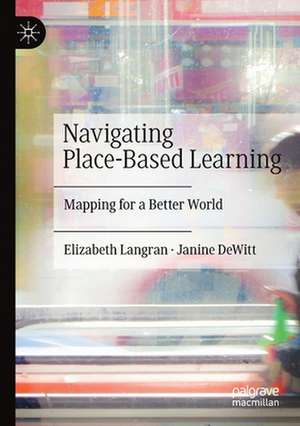Navigating Place-Based Learning: Mapping for a Better World
Autor Elizabeth Langran, Janine DeWitten Limba Engleză Paperback – 6 noi 2021
This book explores how educators can realize the potential of critical place-based pedagogy. The authors’ model leverages the power of technology through strategies such as mobile mapping so that students can read the world and share spatial narratives. The same complexity that makes spaces outside the classroom ideal for authentic, purposeful learning creates challenges for educators who must minimize students taking wrong turns or reaching dead ends. Instructional design process is key and the authors offer exemplars of this from multiple disciplines. Whether students are exploring a local community or a natural environment, place-based inquires must include recognition of privilege and the social dynamics that reinforce inequalities. Concluding with a discussion of the changing social context, the authors highlight how contemporary events add a sense of urgency to the call for a critical place-based pedagogy—one that is more inclusive for all students.
| Toate formatele și edițiile | Preț | Express |
|---|---|---|
| Paperback (1) | 690.76 lei 43-57 zile | |
| Springer International Publishing – 6 noi 2021 | 690.76 lei 43-57 zile | |
| Hardback (1) | 698.15 lei 43-57 zile | |
| Springer International Publishing – 5 noi 2020 | 698.15 lei 43-57 zile |
Preț: 690.76 lei
Preț vechi: 812.66 lei
-15% Nou
Puncte Express: 1036
Preț estimativ în valută:
132.17€ • 138.37$ • 109.37£
132.17€ • 138.37$ • 109.37£
Carte tipărită la comandă
Livrare economică 07-21 aprilie
Preluare comenzi: 021 569.72.76
Specificații
ISBN-13: 9783030556754
ISBN-10: 3030556751
Pagini: 163
Ilustrații: XIX, 163 p. 13 illus., 9 illus. in color.
Dimensiuni: 148 x 210 mm
Greutate: 0.25 kg
Ediția:1st ed. 2020
Editura: Springer International Publishing
Colecția Palgrave Macmillan
Locul publicării:Cham, Switzerland
ISBN-10: 3030556751
Pagini: 163
Ilustrații: XIX, 163 p. 13 illus., 9 illus. in color.
Dimensiuni: 148 x 210 mm
Greutate: 0.25 kg
Ediția:1st ed. 2020
Editura: Springer International Publishing
Colecția Palgrave Macmillan
Locul publicării:Cham, Switzerland
Cuprins
1. Place-Based Learning, Geospatial Literacy, and Maps.- 2. How and Why Place-Based Learning Works.- 3. The Design of Critical Place-Based Inquiry.- 4. Facilitating Student Learning.- 5. Place-Based Inquiry in Action.- 6. Mapping for A Better World.- 7. Afterword.-
Notă biografică
Elizabeth Langran is Professor of Education at Marymount University, USA, and President of the Society for Information Technology and Teacher Education (SITE). She has taught secondary and post-secondary students in the US, Morocco, and Switzerland and holds a doctorate in Instructional Technology from the University of Virginia.
Janine DeWitt is Professor of Sociology at Marymount University, USA. She teaches sociology courses that include place-based and experiential learning, and she co-developed a globally-networked course where she became intrigued by the process of intercultural team-teaching.
Janine DeWitt is Professor of Sociology at Marymount University, USA. She teaches sociology courses that include place-based and experiential learning, and she co-developed a globally-networked course where she became intrigued by the process of intercultural team-teaching.
Textul de pe ultima copertă
This book explores how educators can realize the potential of critical place-based pedagogy. The authors’ model leverages the power of technology through strategies such as mobile mapping so that students can read the world and share spatial narratives. The same complexity that makes spaces outside the classroom ideal for authentic, purposeful learning creates challenges for educators who must minimize students taking wrong turns or reaching dead ends. Instructional design process is key and the authors offer exemplars of this from multiple disciplines. Whether students are exploring a local community or a natural environment, place-based inquires must include recognition of privilege and the social dynamics that reinforce inequalities. Concluding with a discussion of the changing social context, the authors highlight how contemporary events add a sense of urgency to the call for a critical place-based pedagogy—one that is more inclusive for all students.
Caracteristici
Serves as a guide to secondary and university-level educators interested in place-based learning strategies Offers new tools for educators to inform curriculum design in place-based learning classrooms Includes a focus on four central "pedagogical literatures": City as Text, Participatory Mapping, Mobile Learning, and Geospatial Literacy
